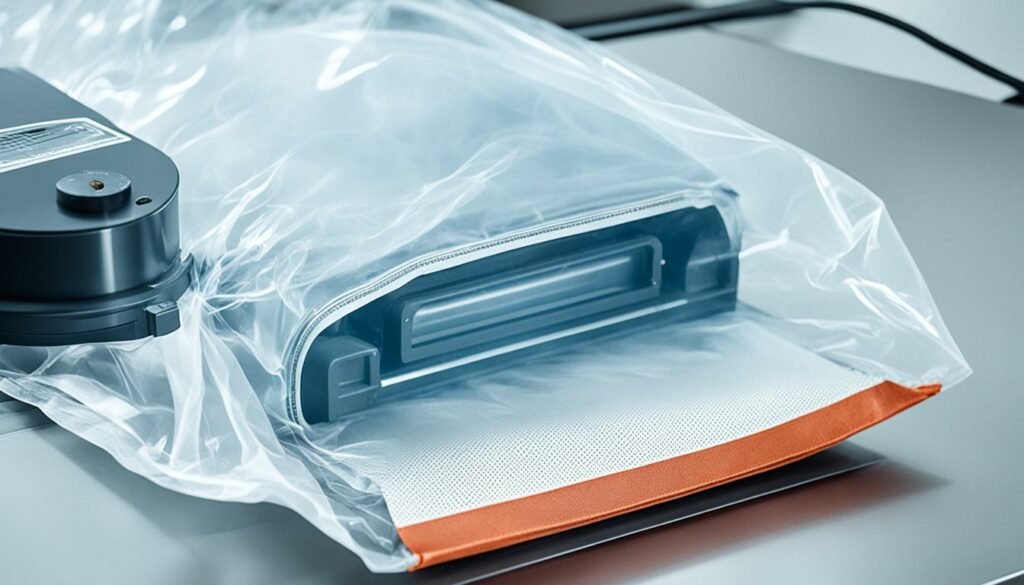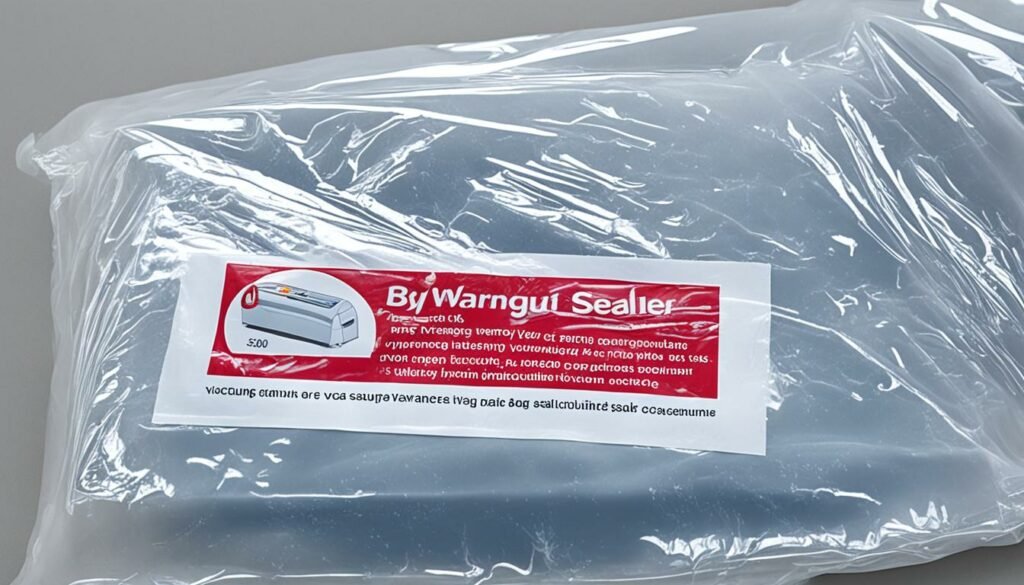Imagine prepping for a big family BBQ. Your freezer is neat, thanks to your vacuum sealer. But, some bags show signs of melting. This exposes food, risking freezer burn. Such issues throw off our food saving plans, causing waste and disappointment.

It’s a common problem: bags in the vacuum sealer melt. We wonder how to keep our food safe. The issue can be from used gaskets, wrong bag setup, or sealing with moisture. Sometimes, the vacuum pump isn’t working right. To fix this, a methodical approach is needed. Check your gaskets and ensure bags are placed well. It’s crucial to find a solution to prevent bag melting.
Understanding Why Vacuum Sealer Bags Melt
Vacuum sealer bags melting is often due to multiple reasons. Knowing these causes allows us to tackle and reduce them effectively.
Heat Settings and Their Impact
Wrong heat settings are a big reason for bags to melt. The seal bar in a vacuum sealer melts the bag ends to seal them. If heat is too high, it can over-melt, causing weak spots or holes.
Changing the seal time might fix this. Decrease time if bags melt. Increase it if they don’t seal right. Getting the heat settings correct stops bag melting.
Material Compatibility
It’s vital to pick the right bag material. Each needs a specific sealing temperature. For example, polyethylene seals at 140°F, but polypropylene needs 248–253°F. Thicker bags might need more heat. This affects how the bags seal and cool down.
Knowing the right material for your sealer avoids issues and makes sealing work well. Status bags, for example, are designed for efficient sealing. They have a ribbed profile for better air flow and can seal up to 50 bags in a row. Find out more about picking the right bags.
Common User Errors
Mistakes by users can also make bags melt. Overfilling bags can cause the seal to be poor. Always leave space and lay the bag flat to get a good seal.
If the bag is not lined up right, it won’t seal well. Check the seal bar often. Make sure bags are dry and not touching the heat source. By doing these simple things, you can make sealing safer and avoid problems.
So, the right settings, the right materials, and how you use the sealer all matter. Knowing and fixing issues in these areas helps stop bag melting. It leads to better, lasting seals.
Identifying Symptoms of Vacuum Sealer Bag Melting
Checking your vacuum sealer bags is key to preventing damage. It’s important to catch any early signs of melting. This stops big problems with your machine and keeps food fresh.
Visible Damage to the Bag
Spotting melted spots is a clear sign your bag is in trouble. If you use your sealer for clothes. Pick the right kind of storage. It keeps your stuff safe from getting too hot and melting.
Stuck Bags in the Machine
Getting your bags stuck happens sometimes. It means a bag has glued to the sealing part due to a worn Teflon cover. Always check these parts as part of bag care. Make sure your materials match the machine’s needs, like this guide suggests. This reduces the chance of getting stuck.

Find signs of trouble early to save your machine and keep your food fresh longer. Doing this improves your maintenance job on your bag sealer.
| Symptom | Cause | Solution |
|---|---|---|
| Visible Damage | Overheating or incompatible materials | Use proper heat settings and compatible bags |
| Stuck Bags | Damaged Teflon cover or incorrect placement | Replace Teflon cover and ensure proper bag placement |
For food, handheld vacuum sealers work great. They help keep your bags from melting. And they make your food last longer.
Preventing Vacuum Sealer Bag Melting
To stop vacuum sealer bags from melting, it’s key to act early. This keeps your seals strong and your tools working longer. We’ll talk about putting bags right and picking those for hot conditions.
Proper Bag Placement Techniques
Proper bag setup is crucial for vacuum sealer bag safety. Here’s how to place them correctly:
- Don’t fill the bag too much. Leave an empty space at the top for a good seal.
- Make sure the bag’s edges are flat and right over the sealer’s bar.
- Avoid having wrinkles or folds where you seal, as these can make the seal weak.
Getting bags in the right place cuts down on the risk of melting during sealing.
Choosing the Right Bags
Picking the best vacuum sealer bags for high heat matters a lot. Here’s what to think about:
- Go for bags that resist high heat, so they won’t melt when sealed.
- Think about bags with many layers for more strength.
- Look for bags that fit your sealer model to work well together.
By focusing on bag setup and the right bag choice, we boost vacuum sealer bag safety and our sealing work’s effectiveness.
Fixing Vacuum Sealer Bag Melting Issues
Dealing with vacuum sealer bag melting is avoidable with good machine care. The sealing bar and Teflon tape are key for a proper seal. They are critical for the sealing process to go smoothly.
Cleaning the Sealing Bar
Residue on the sealing bar can cause not sealing or melting issues. Cleaning it often stops these problems. Wipe it down after every use to keep it working well. This prevents your bags from being damaged.
Replacing the Teflon Tape
Teflon tape is crucial but often not mentioned. It protects the bag from heat. If it’s peeling like in the Food Saver V3840, bags may melt. Change the tape to keep your sealer effective. Always follow the instructions or get help from a pro.
Doing these small maintenance tasks helps prevent bag melting. Use the right bags and make sure they’re well-positioned. This simple care means you’ll seal without problems.
Keep your vacuum sealer in check by cleaning and replacing parts as needed. This practice solves melting issues and lengthens your sealer’s life. Enjoy perfectly sealed bags every time you use it.
Maintenance Tips for Vacuum Sealer Bag Safety
Keeping our vacuum sealer bags safe is key to making them last longer and work better. It’s crucial to check regularly, especially the sealing gaskets. These can wear out over time, causing leaks and making a good seal impossible. By checking these parts often, we help our bags last longer.
Regular Inspection of Components
It’s a good idea to often look at parts like sealing gaskets and the sealing bar for issues. Problems with the sealing bar like not being at a consistent temperature might cause weak seals or even overheat the machine. Make sure bags are properly placed and not too full to ensure a good seal. Plus, it’s important to keep the sealing bar clean from any dirt or leftover material.
Ensuring Dry Conditions
Controlling moisture is crucial for good vacuum sealer bag care. Any moisture on the bag or in the machine can stop it from sealing right. So, always dry the sealing bar and area before you use it. Also, using bags that are made for your machine, as recommended in these tips, helps a lot.
Keeping the vacuum sealer in a cool, dry place also helps it and its bags last longer. Follow the maker’s care tips and use help from places like this forum for fixing problems. This way, you can make sure your vacuum sealer keeps working well.
FAQ
How can we fix bag melting issues in vacuum sealing machines?
To fix bag melting, first, tweak your heat settings. Make sure bags are properly placed. Use bags that your machine can handle. Plus, if parts like the Teflon tape are worn, replace them.
What are the reasons vacuum sealer bags melt?
Excessive heat, wrong bag materials, and user mistakes lead to bag melting. Such errors include filling the bags too much or not putting them in the right spot.
How can heat settings impact vacuum sealer bags?
Wrong heat settings can fry the bags, making them melt. This often happens when the sealing bar’s temperature gets too high.
Why is material compatibility important for vacuum sealer bags?
Not all bags can handle the same heat. Using the wrong ones can mean disaster. Always check your sealer’s requirements to pick the right bags.
What common user errors lead to vacuum sealer bag melting?
Overfilling, placing bags incorrectly, or sealing moist bags are big no-nos. They mess with the seal and can lead to melting.
How can we prevent vacuum sealer bag melting?
Prevention means proper bag setup. Don’t stuff bags too full. Place them right and use top-quality bags specifically designed for your sealer.
What are the signs of visible damage to vacuum sealer bags?
Look for warped or wrinkled bags and odd melting on the seal. These hints show your bags might have gotten too hot or were sealed incorrectly.
What should we do if vacuum sealer bags get stuck in the machine?
If bags get stuck, check if the Teflon cover on the sealing bar is damaged. Clean or replace it to stop bags from sticking.
How do we clean the sealing bar on our vacuum sealer?
Use a soft cloth to wipe the sealing bar clean. This removes anything that might disrupt the sealing process. Regular cleanings are key.
When should we replace the Teflon tape on our vacuum sealer?
Change the Teflon tape when it starts to peel or show damage. Proper tape keeps bags from sticking, ensuring a good seal.
What are the best practices for vacuum sealer bag maintenance?
Check gaskets and the sealing bar often for any wear. Always seal in a dry area and use compatible, high-quality bags. These steps help maintain your sealer.
How can we ensure our vacuum sealer bags maintain durability?
Your bags will last longer if you don’t overfill them. Keep the seal area dry. Store your machine correctly and use bags that can handle the heat.
